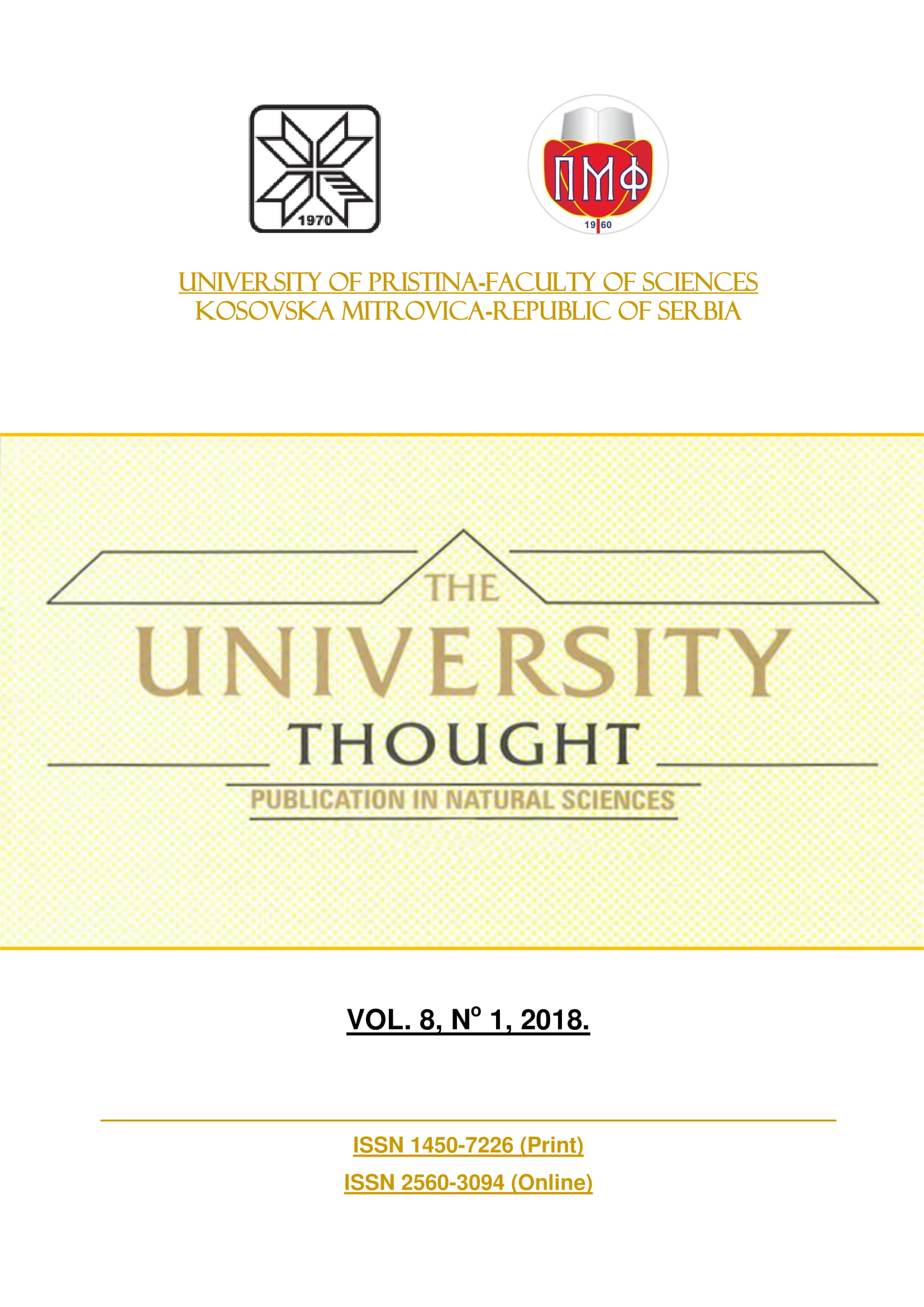THE SPRINGTAILS (INSECTA: COLLEMBOLA) FAUNA AT DIFFERENT MICROHABITATS OF BEČIĆI BEACH, MONTENEGRO
Abstract
Collembola fauna has been investigated at different microhabitats near the beach in Bečići, Montenegro. Samples were collected from four locations: Hotel “Tara”, “Sveti Toma” Church (St. Thomas), Hotel “Naftagas” and “Zelena Stena” (Green Rock). Each of the location presented different microhabitat: under the palm tree, cypresses tree, larch tree and white pine tree. Samples were taken in May and September 2015 and results presented as qualitative findings.
Total number of 30 Collembola species was identified, classified into six families and 17 genera. Representatives of the family Hypogastruridae and Isotomidae were recorded at all of the studied sites, while representatives of the families: Naenuridae, Onychiuridae, Entomobryidae and Sminthuridae were present on some of locations.
The biggest number of species and the highest Collembola population density was found at the Green Stone site, 24 species in total, microhabitat- white pine, and the smallest number of species, 6 on site “St. Thomas” Church, microhabitat- cypresses trees.
References
Bellinger, P.F., Christiansen, K. A., Janssens, F. Checklist of the Collembola of the world. Available from: http://www.collembola.org
Bogojević, J. 1978. Prilog poznavanju faune Collembola Crnogorskog primorja. Glasnik Prirodnjačkog muzeja. Beograd, Vol. 33, pp.157-161.
Chagnon, M., Hébert, C., Paré, D. 2000. Community structure of Collembola in sugar maple forest: relation to humus type and seasonal trends. Pedobiologia, 44, pp. 148-174.
Ćurčić, B.P.M. & Lučić, L.R. 1997. On the Biodiversity of Springtails (Collembola, Insecta) in Yugoslavia (Serbia and Montenegro). Arch. Biol. Sci. Belgrade, 49, pp. 13-14.
Ćurčić, B.P.M., Decu, V., Juberthie, C. 2008. Cave-dwelling Invertebrates in Montenegro. Advences in arachnology and Development Biology. Monographs, 12, pp. 35-55. Vienna-Belgrade-Sofia.
Fernandes, L.H., Nessimian, J.L., Mendonça, M.C. 2009. Structure of Poduromorpha (Collembola) communities in “resting” environments in Brazil. Pesquisa Agropecuária Brasileira, Brasília, 44 (8), pp. 1033-1039.
Gisin, H. 1943. Öcologic und Lebengemeinschaften der Collembolen im schweizerischen Exkusionsgebiet Basels. Revue Suisse de Zoologic, 50, pp. 131-224.
Gisin, H. 1960. Collembolenfaunae Europas. Museum D’Historie Naturelle. Geneve, pp. 312.
Hågvar, S. 1982. Collembola in Norwegian coniferous forest soil. I. Relation to plant communities and soil fertility. Pedobiologia, 24, pp. 255-296.
Hågvar, S. & Abrahamsen, G. 1984. Collembola in Norwegian coniferous forest soil. III. Relation to soil chemistry. Pedobiologia, 27, pp. 331-339.
Lebrun, P. 1976. Effects écologiques de la pollution atmosphérique sur les populations et communaotés de microarthropodes corticoles (Acariens, Collemboles et Ptérygotes). Bull. Soc. Ecol. 7, pp. 417-430.
Ponge, J.F. 1993. Biocenoses of Collembola in atlantic temperate grass-woodland ecosystems. Pedobiologia, 37(4), pp. 223-244.
Prasse, I., 1985. Indications of structural changes in the communities of microarthropods of the soil in an agro-ecosystem after applying herbicides. Agriculture, Ecosystems and Environment 13, pp. 205-215.
Rusek, J., 1989. Collembola and Protura in a meadow-forest ecotone. In: Dallai, R. (Ed.), Third Seminar on Apterygota. University of Siena, Siena, pp. 413-418.
Salmon, S., Ponge, J.F., Van straalen, N.M., 2002. Ionic identity of pore water influences Ph preference in Collembola. Soil Biology and Biochemistry 34, pp. 1663-1667.
Stach, J. 1956. The Apterygoten fauna of Poland in relation to the World fauna of this group of insects. Sminthuridae. Krakow.
Stach, J. 1960. The Apterygoten fauna of Poland in relation to the World fauna of this group of insects. Tribe: Orchesellini. Krakow.
Stach, J. 1963. The Apterygoten fauna of Poland in relation to the World fauna of this group of insects. Tribe: Entomobryini. Krakow.
Sterzyńska, M. 1990. Communities of Collembola in natural and transformed soils of the linden-oak-hornbeam sites of the Mazovian Lowland. Fragmenta Faunistica 34, pp. 165-262.
Vilkamaa, P. & Huntha, V. 1986. Effects of fertilization and Ph on communities in pine forest soil. Ann. Zool. Fenn. 23, pp. 167-174.
Authors retain copyright and grant the journal right of first publication with the work simultaneously licensed under a Creative Commons Attribution License that allows others to share the work with an acknowledgement of the work's authorship and initial publication in this journal.

